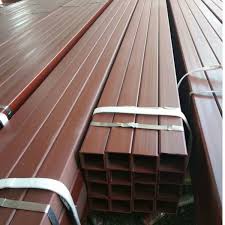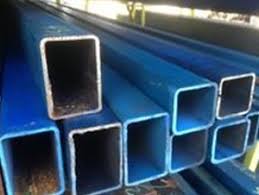Painted hollow steel features
Painted hollow steel profile has some technical features.
1. Steel Grade:
- Higher-strength steel grades: Such as A500 or A992, offer improved mechanical properties like yield strength, ultimate tensile strength, and ductility. However, they may be more difficult to fabricate and may require specialized welding techniques.
- Lower-strength steel grades: While less strong, they may be more formable and easier to weld. They are often used in applications where strength is not a primary concern.

2. Manufacturing Process:
- Cold-formed HSS: Produced by bending and shaping steel sheets or strips at room temperature. This process can result in improved dimensional accuracy and surface finish, but it may limit the achievable wall thicknesses.
- Hot-rolled HSS: Formed by rolling heated steel billets into the desired shape. This process can produce thicker-walled sections and is often used for larger-diameter pipes.
3. Paint Type and Application:
- Paint thickness: A thicker paint coating can provide better corrosion protection but may also affect the appearance and cost.
- Paint quality: High-quality paints with superior adhesion properties and resistance to weathering can significantly extend the service life of the HSS.
- Application method: Proper application techniques, such as spray painting or powder coating, are essential for ensuring a uniform and durable coating.
4. Environmental Factors:
- Exposure to corrosive agents: The type and concentration of corrosive agents in the environment can significantly affect the rate of corrosion and the lifespan of the paint coating.
- Temperature fluctuations: Extreme temperature changes can cause paint to crack or peel, reducing its effectiveness.
- Ultraviolet radiation: Exposure to UV radiation can cause paint to fade or degrade, affecting its appearance and protective properties.
5. Design Considerations:
- Stress concentrations: The presence of sharp corners, notches, or other geometric discontinuities can create stress concentrations, increasing the risk of fatigue failure.
- Load distribution: The way loads are applied to the HSS can influence its performance. Proper design and support can help to minimize stress and prevent premature failure.
- Joint design: The type of joint used to connect HSS members can also affect their performance. Welded joints, for example, may require careful design and inspection to ensure their integrity.
6. Maintenance:
- Regular inspections: Periodic inspections can help to identify signs of corrosion, damage, or deterioration.
- Repainting: When the paint coating becomes damaged or deteriorated, it should be repainted to maintain its protective properties.
- Cleaning: Regular cleaning can help to remove dirt, debris, and contaminants that can accelerate corrosion.
7. Standards and Codes:
- Adherence to relevant standards and codes, such as ASTM, EN, and CSA, can ensure that the HSS meets the required quality and performance criteria for specific applications.
8. Additional Considerations:
- Fire resistance: Painted HSS can be fire-resistant if treated with appropriate coatings or intumescent paints.
- Acoustic properties: The choice of paint and the internal configuration of the HSS can affect its acoustic performance, making it suitable for applications such as noise reduction or sound insulation.
- Sustainability: The use of recycled steel and environmentally friendly paints can contribute to a more sustainable construction process.

By carefully considering these factors, engineers and designers can select the appropriate painted HSS for their projects and ensure its long-term performance and durability.
Price table
| Section Size | Type | Wall Thickness (mm) | Yield Strength (MPa) | Tensile Strength (MPa) | Elongation (%) | Price (USD/ton) |
|---|---|---|---|---|---|---|
| Small (50×50 mm) | Standard | 2.0 | 250 | 400 | 20 | 740 |
| Small (50×50 mm) | Premium | 2.5 | 275 | 450 | 22 | 770 |
| Medium (100×100 mm) | Standard | 3.0 | 250 | 400 | 18 | 760 |
| Medium (100×100 mm) | Premium | 3.5 | 300 | 460 | 20 | 790 |
| Large (150×150 mm) | Standard | 4.0 | 250 | 400 | 15 | 780 |
| Large (150×150 mm) | Premium | 4.5 | 320 | 470 | 18 | 810 |
| Extra Large (200×200 mm) | Standard | 5.0 | 250 | 400 | 12 | 800 |
| Extra Large (200×200 mm) | Premium | 6.0 | 350 | 500 | 15 | 880 |
Legend:
- Standard: Basic painted hollow sections with regular properties.
- Premium: Higher quality painted hollow sections with improved mechanical properties.
- Yield Strength (MPa): Stress at which the material begins to deform plastically.
- Tensile Strength (MPa): Maximum stress that the material can withstand.
- Elongation (%): The amount the material can stretch before breaking.
